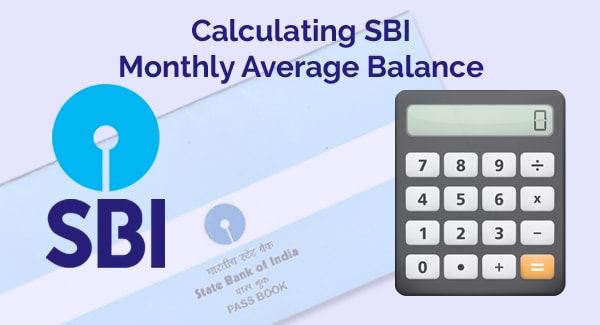According to State Bank of India, customers need to maintain certain minimum balance in their bank accounts in order to keep them in an operative state. Inadequate account balance leads to a penalty. The SBI is one of India’s largest lenders and its accounts are divided into four categories of branches on the basis of locations. These are metro branch, urban branch, semi-urban branch and rural branch. Different branches require different levels of Average Monthly Balance (AMB) and in their absence charges a small penalty fees from the customers.
To avoid any kind of penalty charges, the customers must maintain the required minimum balance. Here we will help you understand, how your AMB is calculated to ensure the fulfillment of the requirement and optimising the amount of funds kept in a savings account.

Calculating SBI Account Average Monthly Balance
You can find below a quick algorithm to calculate the AMB for bank savings accounts.
Let’s assume that a bank requires an AMB of Rs 5,000.
Now for the month of August, the AMB would be calculated as under.
On 1st August, the account balance is Rs. 4,000.
On 11th August, the customer withdraws a sum of Rs. 3,000.
On 17th August, the customer deposits a sum of Rs. 9,000.
From 1st August to 11th August, i.e., 11 days, total balance will be Rs. (4000*11) = Rs. 44,000
From 12th August to 17th August, i.e., 6 days, total balance will be Rs. (1000*6) = Rs. 6,000
From 18th August to 31st August, i.e., 14 days, total balance will be Rs. (10000*14) = Rs. 1.4 lakh
Hence, total balance comes to Rs. 1.9 lakh and the average for 31 days will be Rs. 6,129. Since, this amount is above the required limit so the account will face no penalty. The calculation of total number of days is done on the basis of the day’s closing balance.
Example with Statement
Below we have SBI statement with multiple transactions in January 2019 month. We are assuming this account need average minimum balance of Rs. 3000/. The account had no balance before 1st January and first deposit was made on 1st January. We did addition of all 31 day’s day end balance which came to 1,12000. Then divided this amount by number of days in the month (31 days) resulting 3612.30, which is above the minimum balance required. So this account will not be charged for not maintenance of AMB.
| Date (Value Date) | Description | Ref No./Cheque No. | Debit | Credit | Balance |
| 1-Jan-19 | CSH DEP (CDM) | 5000 | 3000 | ||
| 2-Jan-19 | 3000 | ||||
| 3-Jan-19 | 3000 | ||||
| 4-Jan-19 | 3000 | ||||
| 5-Jan-19 | By Transfer IMPSXXXX | XXXX | 1000 | 2000 | |
| 6-Jan-19 | 2000 | ||||
| 7-Jan-19 | 2000 | ||||
| 8-Jan-19 | 2000 | ||||
| 9-Jan-19 | By Transfer NEFTXXXX | XXXX | 5000 | 7000 | |
| 10-Jan-19 | 7000 | ||||
| 11-Jan-19 | 7000 | ||||
| 12-Jan-19 | 7000 | ||||
| 13-Jan-19 | 7000 | ||||
| 14-Jan-19 | 7000 | ||||
| 15-Jan-19 | 7000 | ||||
| 16-Jan-19 | ATM WDL-ATM CASH | XXXX | 4000 | 3000 | |
| 17-Jan-19 | 3000 | ||||
| 18-Jan-19 | 3000 | ||||
| 19-Jan-19 | 3000 | ||||
| 20-Jan-19 | 3000 | ||||
| 21-Jan-19 | 3000 | ||||
| 22-Jan-19 | 3000 | ||||
| 23-Jan-19 | 3000 | ||||
| 24-Jan-19 | 3000 | ||||
| 25-Jan-19 | 3000 | ||||
| 26-Jan-19 | 3000 | ||||
| 27-Jan-19 | By Transfer IMPSXXXX | XXXX | 1000 | 2000 | |
| 28-Jan-19 | 2000 | ||||
| 29-Jan-19 | 2000 | ||||
| 30-Jan-19 | 2000 | ||||
| 31-Jan-19 | 2000 | ||||
| Total | 112000 | ||||
| Average (Total / 31 Days) | 3612.90 |
Charges for Non-maintenance of Average Monthly Balance (AMB) in SBI accounts
SBI customers having savings accounts in lender’s metro and urban branches are needed to maintain an AMB of Rs. 3,000. The banking major charges a penalty amount that ranges from Rs. 10 plus GST (goods and services tax) to Rs. 15 plus GST if the customers fail to maintain the required AMB in their metro and urban branches.
The table given below shows the actual penalty charges as mentioned on the official website of SBI.
| Metro and Urban Branch (Required AMB of Rs. 3,000) | Charges |
| Shortfall <= 50% | Rs. 10 + GST |
| Shortfall > 50-75% | Rs. 12 + GST |
| Shortfall > 75% | Rs. 15 + GST |
Customers with accounts in semi-urban branches are needed to maintain an AMB of Rs. 2,000. The bank charges a penalty amount that ranges from Rs. 7.5 plus GST to Rs. 12 plus GST if the customers fail to have this AMB in their semi-urban branch.
The table given below shows the actual penalty charges as mentioned on the official website of SBI.
| Semi-urban Branch (required AMB of Rs. 2,000) | Charges |
| Shortfall <= 50% | Rs. 7.50 + GST |
| Shortfall > 50-75% | Rs. 10 + GST |
| Shortfall > 75% | Rs. 12 + GST |
Customers having their account in a rural branch need to maintain an AMB of Rs. 1,000. SBI serves penalty charges to the tune of Rs. 5 to 10 plus GST for non-compliance with the AMB rules in the rural branches.
The table given below shows the actual penalty charges as mentioned on the official website of SBI.
| Rural (required AMB of Rs. 1,000) | Charges |
| Shortfall <= 50% | Rs. 5 + GST |
| Shortfall > 50-75% | Rs. 7.50 + GST |
| Shortfall > 75% | Rs. 10 + GST |
Note: In certain cases SBI offers a waiver on AMB and no penalty charges are issued in the instance of low bank balance. These are known as zero balance savings accounts and exempt customers from maintaining any particular minimum average balance. The examples include Financial Inclusion accounts such as PMJDY accounts, basic savings bank deposit accounts, Phela Kadam and Pheli Udaan account.
What RBI Say About AMB
The RBI guidelines maintain that charges for non-maintenance of AMB in savings bank accounts should be “reasonable and not out of line with the average cost of providing the services”. This mandate was directed after reviewing the AMB policies of different banks that charged their customers an average rate of 78 percent on an annual basis for the shortfall amount.
What if you can’t maintain AMB?
If you believe that it would be difficult to maintain AMB in your multiple accounts, then you need to take some immediate actions. First, instead of maintaining a regular savings account, you can switch to SBI’s Basic Savings Bank Deposit Account (BSBDA), or a Jan Dhan Yojna Account.

The Reserve Bank of India (RBI) mandates all other Indian banks to offer such facility to people desiring to open a bank account. As a secondary account, the BSBDA account would offer you more flexibility to effectively manage your regular savings bank account. To open BSBDA you don’t need any minimum depository amount or any need to maintain an AMB. The interest rate of a BSBDA will be the same as that of the regular savings account. According to RBI, there are no restrictions on deposits or withdrawals from this type of account. There is also no limit on transactions in the BSBDA. However, this type of account does come with restrictions on the number of transactions.
Specific section of citizens like students, pensioners, and newly employed could find it difficult to maintain minimum balances. Moreover, some individuals like to maintain 3-5 bank accounts for different purposes and may find it hard to maintain an AMB in each one of them. Consequently, one might consider keeping one primary account with unlimited transactions along with a BSBDA with limited transactions.
Waiver in AMB for Select Categories by SBI
In certain categories there are no requirements for maintenance of Average Monthly Balance. These categories include:
- Financial Inclusion accounts such as PMJDY accounts.
- No Frill accounts.
- Salary Package accounts.
- Basic Savings Bank Deposit accounts.
- BSBDA- Small Accounts.
- Phela Kadam and Pheli Udaan accounts.
- Minors up to the age group of 18 years.
- Pensioners (all categories).
- Recipients of social security welfare benefits. (Direct Benefits Account).
- Students up to the age of 21 years.
Tips to Maintain Average Balance
- Keep an awareness of your account’s average account balance.
- Have less number of accounts.
- Open your bank accounts in public sector banks.
- If eligible, then open type of account listed in above.
- Hold large amount for more days.
- Opt for SMS alerts.



